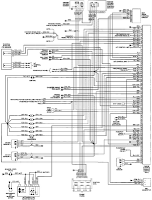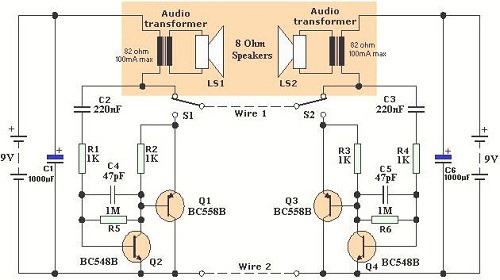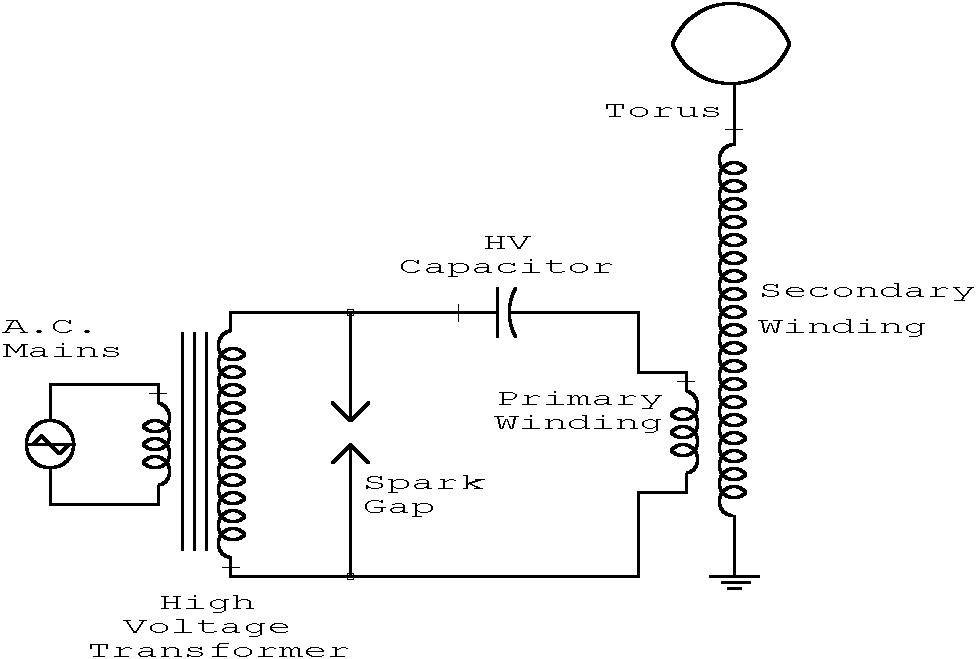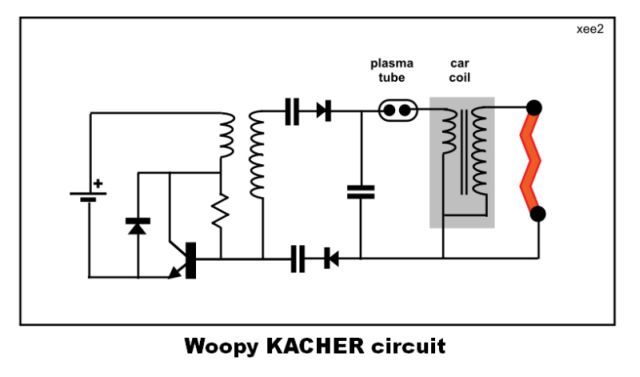
Tesla Coils Wiring
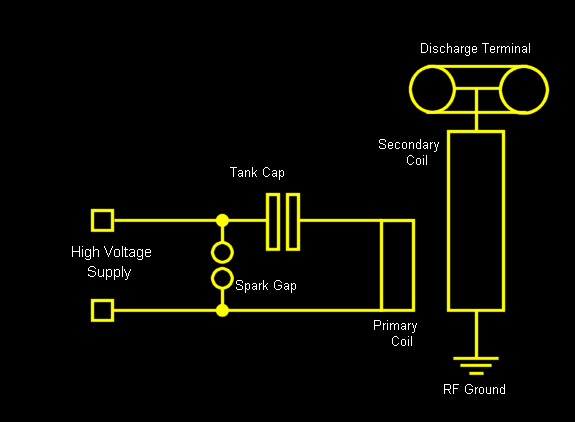
Due to the high voltages present in the Charge and Primary sections, it is logical to seek cables with high voltage ratings, such as neon sign cables, medical X-ray equipment cables, and car engine spark plug leads. The first two options are suitable for connecting the NST (Neon Sign Transformer) to the spark gap, while spark plug leads are ineffective due to their high resistance. However, expensive high-voltage cables are not necessary, as ordinary wires can also be used effectively. The key consideration is insulation. For a circuit to function, wires must conduct electricity between components. While a bare wire can conduct electricity, it poses the risk of accidental contact and short circuits. Additionally, high voltages can present electrocution hazards. Insulation addresses these issues, but suitable high-voltage cables tend to be costly. A practical alternative is to use ordinary low-voltage cables or bare wire, utilizing air as an insulator, similar to the method employed by the National Power Grid. It is essential to secure the wires to prevent contact with conductive materials and to maintain a safe distance from operators. All conductors, except superconductors, resist current flow. The resistance value is influenced by the conductor material and size. As the cross-sectional area decreases or the wire length increases, resistance increases. Higher resistance results in greater energy loss as heat. For instance, the heating element in an electric kettle employs high-resistance wire to generate heat, while the wire connecting the kettle to the wall socket has low resistance to minimize heating. High-current connections in the Primary section necessitate thick cables to minimize resistance. Cables C, D, and E are suitable for high-current Tesla Coil applications but should be treated as single conductors. Cable F is also appropriate for high currents but may be less accessible in stores. The low-current Charge section can utilize thin cables without significant power loss, with cables A and B being adequate. Removing the outermost layer of insulation from cables C, D, and E allows the individual wires to be used effectively. The skin effect describes how current primarily flows in the outer layer of a conductor. The skin depth indicates the thickness of the conductor where most current flows. As frequency increases, the center of the conductor becomes less utilized for current flow, resulting in increased resistance at RF frequencies. Consequently, a large cable may exhibit low resistance for DC current but higher resistance for RF applications. For RF ground connections, using copper sheet cut into strips can be more efficient, as it avoids wasted metal that would occur in a round conductor.
High-voltage applications, such as those found in Tesla Coils, require careful consideration of wire selection to ensure safety and efficiency. The insulation properties of the wire are critical, particularly in high-voltage scenarios where accidental contact can lead to hazardous situations. Ordinary low-voltage cables can be effectively utilized by maintaining proper spacing and securing the wires to prevent unintentional contact with conductive surfaces. This method not only reduces costs but also leverages air as a natural insulator, which can be particularly advantageous in high-voltage applications.
When selecting cables for high-current applications, it is essential to consider factors such as the material, cross-sectional area, and length of the wire. The resistance of the wire directly impacts the efficiency of the system, as higher resistance leads to greater energy loss in the form of heat. Therefore, using thicker cables for high-current connections is advisable to minimize resistance and ensure optimal performance.
In RF applications, the skin effect must be taken into account, as it significantly influences the effective resistance of conductors at higher frequencies. The utilization of materials such as copper sheets for RF ground connections can enhance efficiency and reduce material waste, providing a more effective solution than traditional round conductors. Overall, careful consideration of cable selection, insulation, and conductor properties is vital for the reliable operation of high-voltage and high-current electronic circuits.Because of the high voltages found in a Charge & Primary sections it seems natural to look for cable with high voltage ratings, such as neon sign cable, medical X-ray equipment cable & car engine spark plug leads. The first two would be fine for connecting the NST to the spark gap but the spark plug leads are useless (too high a resistance).
Howev er, you don`t need to spend lots of money on fancy HV cable because all sorts of ordinary wire would work too. All you need to do is think about insulation. For a circuit to work you need wires to conduct the electricity between the components. A bare piece of wire will do this perfectly but you now have the problem of wires accidentally touching and shorting out.
Depending on the voltage being used you may also have the added risk of electrocution! Insulation is used to solve both these problems but for high voltages, like in a Tesla Coil, the cost of suitably insulated cable is high. The solution is to use ordinary low voltage cable, or bare wire, and use air as your insulatior (just like the big boys do with the National Power Grid!).
All you need to do is to secure the wires in such a way that they cannot short against anything conductive and are at a safe distance from operator`s hands. All conductors, except for `superconductors`, resist the flow of current through them. The value of this resistance is determined by the material used for the conductor and by its size. As the cross-sectional area `a` gets smaller, or the length of the wire `l` gets longer, the resistance `R` increases.
The higher the resistance the more electrical energy is used just in fighting against it. This causes power to be lost in the form of heat. Example: The heating element in an electric kettle uses wire with a high resistance to generate heat. The wire connecting the kettle to the wall socket has a very low resistance, to avoid heating. High current connections in the `Primary` section require thick cables to keep resistance values to a minimum.
Cables `C`, `D` and `E` can be used for high current Tesla Coil use but should be treated as single conductors (see below). Cable `F` is good for high currents too but not as easy to find in the shops. The low current `Charge` section can use thin cable without any measurable loss of power. Cables `A` and `B` are fine. By removing the outermost layer of insulation from cables `C`, `D` and `E` the individual wires are perfect too (see below).
Skin effect is the term used to describe current flower primarily in the outer layer, or skin, of a conductor. The skin depth gives the thickness of conductor in which most of the total current flows. The above cross-section pictures show that as frequency increases the centre of the conductor becomes less and less used for current flow.
In practice this means that although your big fat cable may have a low resistance to DC current flow, at RF frequencies the resistance increases considerably. Note how the metal at the centre of the wire is not used and is therefore wasted expense. For my RF ground cable I cut up a roll of copper sheet to make a 2 inch wide by 6 thou strip. If this amount of copper had been a round conductor, there would have been wasted metal at its centre.
🔗 External reference
High-voltage applications, such as those found in Tesla Coils, require careful consideration of wire selection to ensure safety and efficiency. The insulation properties of the wire are critical, particularly in high-voltage scenarios where accidental contact can lead to hazardous situations. Ordinary low-voltage cables can be effectively utilized by maintaining proper spacing and securing the wires to prevent unintentional contact with conductive surfaces. This method not only reduces costs but also leverages air as a natural insulator, which can be particularly advantageous in high-voltage applications.
When selecting cables for high-current applications, it is essential to consider factors such as the material, cross-sectional area, and length of the wire. The resistance of the wire directly impacts the efficiency of the system, as higher resistance leads to greater energy loss in the form of heat. Therefore, using thicker cables for high-current connections is advisable to minimize resistance and ensure optimal performance.
In RF applications, the skin effect must be taken into account, as it significantly influences the effective resistance of conductors at higher frequencies. The utilization of materials such as copper sheets for RF ground connections can enhance efficiency and reduce material waste, providing a more effective solution than traditional round conductors. Overall, careful consideration of cable selection, insulation, and conductor properties is vital for the reliable operation of high-voltage and high-current electronic circuits.Because of the high voltages found in a Charge & Primary sections it seems natural to look for cable with high voltage ratings, such as neon sign cable, medical X-ray equipment cable & car engine spark plug leads. The first two would be fine for connecting the NST to the spark gap but the spark plug leads are useless (too high a resistance).
Howev er, you don`t need to spend lots of money on fancy HV cable because all sorts of ordinary wire would work too. All you need to do is think about insulation. For a circuit to work you need wires to conduct the electricity between the components. A bare piece of wire will do this perfectly but you now have the problem of wires accidentally touching and shorting out.
Depending on the voltage being used you may also have the added risk of electrocution! Insulation is used to solve both these problems but for high voltages, like in a Tesla Coil, the cost of suitably insulated cable is high. The solution is to use ordinary low voltage cable, or bare wire, and use air as your insulatior (just like the big boys do with the National Power Grid!).
All you need to do is to secure the wires in such a way that they cannot short against anything conductive and are at a safe distance from operator`s hands. All conductors, except for `superconductors`, resist the flow of current through them. The value of this resistance is determined by the material used for the conductor and by its size. As the cross-sectional area `a` gets smaller, or the length of the wire `l` gets longer, the resistance `R` increases.
The higher the resistance the more electrical energy is used just in fighting against it. This causes power to be lost in the form of heat. Example: The heating element in an electric kettle uses wire with a high resistance to generate heat. The wire connecting the kettle to the wall socket has a very low resistance, to avoid heating. High current connections in the `Primary` section require thick cables to keep resistance values to a minimum.
Cables `C`, `D` and `E` can be used for high current Tesla Coil use but should be treated as single conductors (see below). Cable `F` is good for high currents too but not as easy to find in the shops. The low current `Charge` section can use thin cable without any measurable loss of power. Cables `A` and `B` are fine. By removing the outermost layer of insulation from cables `C`, `D` and `E` the individual wires are perfect too (see below).
Skin effect is the term used to describe current flower primarily in the outer layer, or skin, of a conductor. The skin depth gives the thickness of conductor in which most of the total current flows. The above cross-section pictures show that as frequency increases the centre of the conductor becomes less and less used for current flow.
In practice this means that although your big fat cable may have a low resistance to DC current flow, at RF frequencies the resistance increases considerably. Note how the metal at the centre of the wire is not used and is therefore wasted expense. For my RF ground cable I cut up a roll of copper sheet to make a 2 inch wide by 6 thou strip. If this amount of copper had been a round conductor, there would have been wasted metal at its centre.
🔗 External reference
